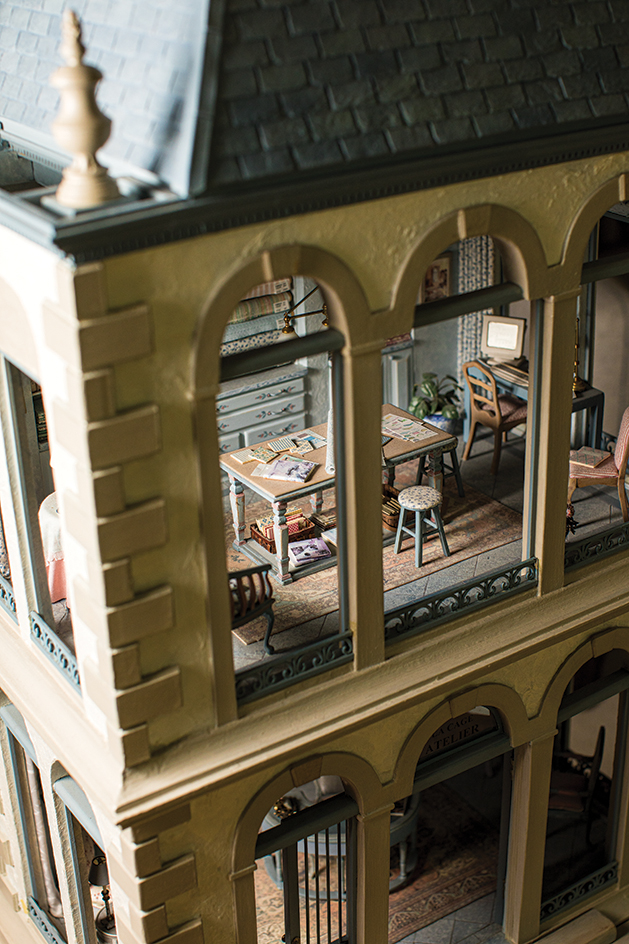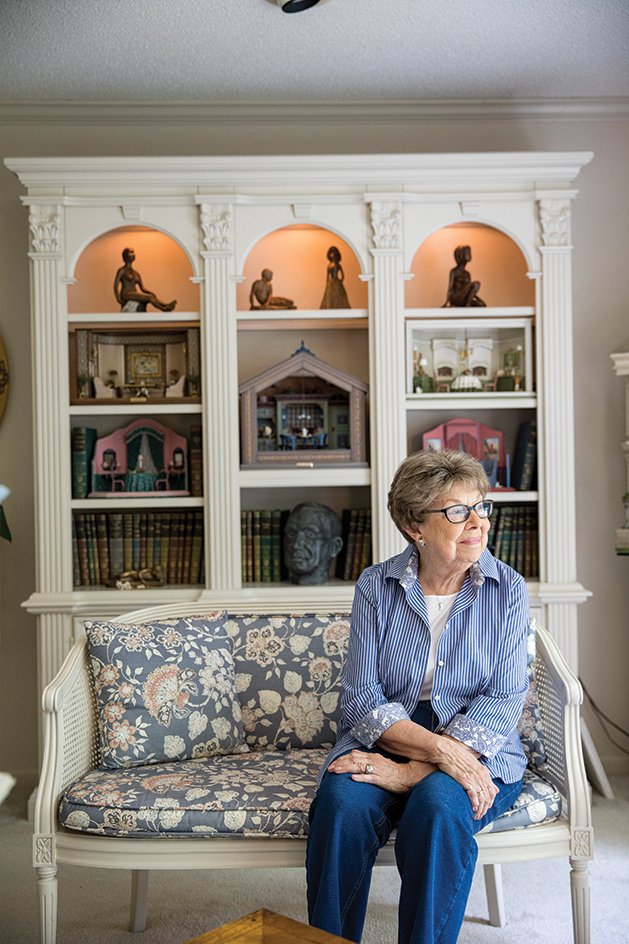
At first blush, one would think their story began with a chance meeting in Oakland, Calif. She—a Parisian designer. He—an aspiring novelist from Normandy. Their histoire d’amour appears to travel to a private French island, a quaint village in Provence, Victorian San Francisco and the fjords of Norway.
In reality, Renee and Philippe’s affaire de cœur began in the creative mind of Plymouth’s Dureen Ruff, an artisan of miniatures and creator of The Cage Series, a quintet of bird cages turned into miniature homes at the hands of Ruff’s impeccable research, attention to detail and artistic acumen.
Every artist needs a muse, and the fictional lives of Renee and Philippe provided Ruff with the aspirational foundation for her bird cage series, created from 1999–2003.

To understand the story of Ruff’s creations, one must start nearly at the beginning. In the 1960s, Ruff, under the artist’s name of d. Anne, created small paintings and sculptures, which were sold at Marion Nellermoe’s Gift Shop in Wayzata and in Minneapolis’ Uptown area. Move a decade ahead, and she had a two-year exclusive deal with The Children’s Shop in Wayzata and White Bear Lake, where her handcrafted upholstered miniature furniture was sold. Dayton’s also sold the line, as did Marshall Field’s in Chicago. Her work was later sold at countrywide trade shows, to which she’d travel to as many as 8-10 shows a year. A global mail order business also carried Ruff’s products, and some can still be found online through her Etsy site and other collectors.
Ruff developed a number of processes for creating miniature elements, and she later offered kits that helped other miniaturists create items themselves. Ruff’s Pretty Pleat Pleater, which aids in pleating fabric for miniature curtains, is still available for purchase.

Wayzata offered Ruff another creative avenue in 1999 by way of an upscale furniture shop, where she spotted a $200, two-story wood and metal birdcage nesting alone on a top shelf. “I looked at it, and I thought I could create two rooms in that birdcage,” she says. Six weeks later La Cage de l’Ile was created and sold for thousands of dollars to a buyer from British Columbia during a miniatures trade show in Chicago.
The next year, her Chateau La Cage Chambre d’Hote sold at a Philadelphia trade show to a buyer from Wheeling, W. Va.—for double the price of the first cage. Understand—these miniature homes are not your standard dollhouses. They are truly works of art, with Ruff meticulously researching the cages’ locales, including historical references and décor styles (color stories, furniture styles and the like).
A third buyer queued up for La Cage Atelier even before Ruff began working on it. Now is where the story becomes a bit more personal. “By the time I had finished it, I felt, this is me … I simply couldn’t sell it,” Ruff says. Her husband, Rick, encouraged her to call the buyer, who graciously understood Ruff’s reluctance and offered to purchase the next cage.
But, that sale never came to pass. Ruff went on to create three more cages, all of which are now on display in her home. “There was so much of me in them that I just couldn’t part with them,” she says. “As I walk around and look at them, I remember all the decisions I made while decorating them.” While she’s traveled extensively, Ruff does live a bit vicariously through Renee and Philippe and their dreamy dwellings. “I look at the cages and think of my characters and how they relate,” she says.

The idea of the couple was borne during the creation of the first cage. “As I was putting it together, I thought, ‘Who would live in this?’ I created that little story about them,” Ruff says. Since they once lived so deeply within her imagination and creative forces, does Ruff “miss” Renee and Philippe? “No,” she says. “They are still sort of sitting in my memory. Their stories are still with me in the cages that I have.”
Artists, at times, suffer regret over creative decisions. As Ruff sees the fruits of her labors on a daily basis, does she, too, have some urges to “renovate” the birdcages? “No,” she says. “I can answer that very firmly. I like the way I did them.”
It’s interesting to consider where one’s creative force originates. “I’ve been interested in drawing and doing creative things ever since I was a little girl,” Ruff says. “It’s just who I am. We are all given certain talents or interests, and that one has been with me since I was young.”
Given her successful career in the world of miniatures, one is curious to know if Ruff had a dollhouse growing up in Grand Forks, N.D. Surprisingly, she didn’t. “I used boxes [butter boxes and other food containers] and created the little rooms as a child,” she says. “My grandmother [Helen Johnson] taught me how to sew, so fabrics were always part of my life.” Ruff adds, “I came into this world with a particular creativity pattern, so I enjoyed … anything I could make with my hands.”
Miniature Masterpieces
To celebrate Ruff’s 90th birthday last February, her children Sue Wellman, Kris Ruff, Steve Ruff and Anne Marie Ruff Grewal wrote Miniature Masterpieces: The Cage Series (Open Door Press), a tribute to their mother’s artistic magnum opus.
“… as we started to look more closely at the cages and the photographs, we realized that we had never looked at them in such detail,” Grewal says. “We were really glad to have the opportunity to see our mother’s work a bit more objectively and really appreciate what remarkable works of art she had made.”
“We gained a new respect for her talents,” Kris Ruff says, also noting that, “Her creativity was definitely a big influence on all of us.”
“Having this book is just thrilling to me,” Ruff says. “It’s a beautiful book.”
While it certainly is a treasured family keepsake, miniature enthusiasts might find it to be a wonderful addition to their collections. ($49.95 on esty.com)
The book not only visually highlights The Cage Series, it also provides a closer look at each structure and shines a brighter light on Renee and Philippe’s life together. While that section reads much like a treatment for a miniseries or feature film, Ruff prefers that Renee and Philippe live not on the silver screen, but tucked away in her imagination.
La Cage de l’Ile—Island retreat
On their honeymoon, Renee and Philippe purchase a rundown two-story structure on a private French island. They turn it into a retreat, where Philippe writes, and Renee taps into her creativity. The décor includes Chippendale-style upholstered furniture to reflect Renee’s French background, and a bamboo-style armoire holds Philippe’s collection of rare first-edition books. Note: The upholstered second-story dome replicates a treatment Ruff used on the walls of her own master bedroom, and the sitting room’s architectural books and magazines are reproductions of actual reference materials she used for the project.
Chateau La Cage Chambre d’Hote–Bed and breakfast
Philippe’s Aunt Sophie converted her chateau in Provence into a bed and breakfast, and she asked the couple to create a cage-style structure for her garden. It is used as a bridal cottage for couples renting Sophie’s chateau for weddings. Guests will find ceramic roosters and chickens from Sophie’s collection. Note: The top of the dresser features a painted faux marble finish, which is a tribute to Ruff’s grandfather, who used the technique in public buildings that he was commissioned to paint in North Dakota.
La Cage Atelier–Renee’s design studio
Renee had a dream of starting her own design firm. Once the sales of Philippe’s novels took off, they were well able to afford such an endeavor, and she left the employ of the House of Fortuny, the venerable Italian fabric house. The venue had been a pastry shop, and renovation revealed that the original ceilings had been elaborately painted by a local artist in 1763. Note: This piece reflects some of Ruff’s passions, including the second story’s blue and white porcelain objets d’art. She also loves fabrics, bolts of which are placed in a second-story room.
La Cage Victoriana–San Francisco pied-à-terre
Renee’s former colleague and her husband commissioned Renee to renovate a gardener’s cottage behind a Victorian home, which is now a growing architectural firm. Renee employs deep red and soft cream colors. The structure’s interior is inspired by American writer Edith Wharton. Note: The crossword puzzle book and dictionary at the small bedroom table are a wink to Ruff’s daily crossword puzzle habit.
La Cage Norge–Norwegian stabbur
Renee and Philippe visit Renee’s mother, Monique, who lives on her new husband’s farm in Norway. The couple stays in a traditional stabbur, which has been converted into a guest cabin. Plot twist: Renee and Philippe announce the impending arrival of their baby. The stabbur features traditional Norwegian color schemes, décor and alcove box beds. Note: The framed photograph on the shelf in one of the alcoves is Ruff’s grandmother Helen Johnson. The Singer sewing machine is much like the one Johnson used to sew Ruff’s clothing.









